Ein Beitrag von: Carsten Faobam

kwerfeldein – Fotografie Magazin
Lomography is a quite unknown term, but many of us practice it more than once. Actually, what some consider mistakes like exposure defects or over-saturated colors are what makes lomography so special. This movement was born in early ‘90s by a group of Viennese students who discovered the Lomo LC-A camera while on vacation in Prague. Since then lomography has Continue Reading
The post Break the Rules: 100 Lomo Photography Ideas to Get Inspired appeared first on Photodoto.
Ein Beitrag von: Isabelle
Oft wird die arme Tomate ja ein bisschen unterschätzt. Aufgezogen in Gewächshäusern, in Plastik gehüllt und viel zu kalt in Kühlhäusern eingesperrt, was für ein trauriges Leben. Und häufig genug fristet sie dann ein undankbares Dasein in Viertel zerteilt auf einem Eisbergsalat und hat nur ein paar einsame Gurkenscheiben, die ihr Gesellschaft leisten. Es ist ein Jammer.
In Südtirol, da wo die Berge hoch sind, der Himmel weiter und blauer, die Wiesen grüner und die Sonne lacht, da haben die Menschen einen anderen Namen für die Tomate. Einen wunderschönen: Paradeiser. Paradiesapfel.
Und der italienische Name für die Tomate, den kennt Ihr bestimmt, ist Pomodoro. Goldapfel. Und dort, in Bella Italia, wird die Tomate auch wie eine Königin behandelt. Ehre, wem Ehre gebührt.
Angeregt durch ein köstlich klingendes Rezept in der Essen & Trinken haben wir diesen köstlichen Salat aus langsam im Ofen geschmorten Tomaten ausprobiert. Was den Tomaten hier in unseren Gefilden bisher an Sonne gefehlt hat, das bekommen sie jetzt im Backofen. Ist wohl ein bisschen wie eine Sonnenbank.


Portionen: 4 Beilagen
Zeit: ca. 1 Stunde und 20 Minuten, davon aktiv zu tun ca. 20 Minuten
Zutaten
800 g kleine Tomaten
2 Knoblauchzehen
3 Stiele Thymian
12 EL Olivenöl
30 g Pinienkerne
Meersalz und Pfeffer aus der Mühle
4 Stiele glattblättrige Petersilie
8 – 10 dunkle Oliven
1 rote Zwiebel
4 EL Aceto Balsamico
30 Parmesan am Stück
8 Scheiben Baguette
Zubereitung
Die Tomaten waschen, waagerecht halbieren und mit der Schnittstelle nach oben auf ein Backblech legen. Den Knoblauch schälen, in dünne Scheiben schneiden und zusammen mit dem gezupften Thymian auf den Tomatenhälften verteilen. Salz, Pfeffer und 4 EL Olivenöl über die Tomaten geben, das Ganze dann bei 80°C (Heißluft) eine gute Stunde schmoren lassen.
In der Zwischenzeit die Pinienkerne ohne Fett in einer Pfanne kurz anrösten, den Parmesan in Späne hobeln, die Zwiebel in dünne Ringe schneiden und die Petersilie in kleine Stückchen zupfen.
Nach einer guten Stunde die Tomaten aus dem Ofen nehmen und etwas abkühlen lassen. Die Tomaten und den entstandenen Sud vorsichtig trennen, den Sud mit 6 EL Olivenöl und dem Balsamico mischen. Petersilie hinzugeben und mit Salz und Pfeffer abschmecken. Mit den Tomaten, den Zwiebeln und den Oliven mischen.
In einer beschichteten Pfanne die Baguettescheiben in dem verbliebenen Olivenöl anrösten.
Den Tomatensalat auf einer Platte anrichten, mit den Pinienkernen und den Parmesanspänen bestreuen. Dazu das Baguette reichen.


Fotorezept
Dieser Tometensalat sollte ursprünglich und rustikal rüberkommen, frisch aus dem Garten und gleich zubereitet für den Sommerabend am Grill. Hungrigmachend. Teller und Gabel sind Flohmarktfunde und sehen bewusst nicht zu fein aus. Der Untergrund ist eine rustikalere Holzkiste. Das grüne Petersilienblatt würzt nicht nur den Salat, sondern auch das Bild, das Tomatenrot braucht unbedingt diesen Kontrapunkt, sonst wird’s fad.
Du hast auch ein leckeres Rezept und die passenden Food-Fotos dazu, die einem das Wasser im Munde zusammenlaufen lassen? Dann werde einfach selbst Teil von „Augenschmaus“!
kwerfeldein – Fotografie Magazin
Mir ist aufgefallen, dass wir in der Serie bislang noch keinen Wasserfall gezeigt haben. Das wollen wir heute ändern, denn auch Deutschland hat wunderschöne Wasserfälle zu bieten. Besonders im Schwarzwald findet man sie. Zum Beispiel diesen hier, den Geroldsauer Wasserfall, im Nordschwarzwald, etwas südlich von Baden Baden gelegen.
Schon oft war ich dort fotografieren und stand im kalten, klaren Wasser des Grobbachs. Es ist schon imposant, wie sich das Wasser seinen Weg bahnt und in lautem Getöse in die Tiefe stürzt. Das Schöne ist, dass der Wasserfall sehr gut zugänglich ist und ich mich direkt davor platzieren kann, um meine Fotos zu machen.
Doch es ist nicht nur der Hauptwasserfall, der mich immer wieder dorthin zieht. Auch der Flusslauf ist sehr fotogen. Für die anderthalb Kilometer vom Parkplatz bis zum Wasserfall brauche ich wegen der zahlreichen Fotogelegenheiten meistens schon über eine Stunde. Alle paar Meter wartet ein neues Motiv und jedes Mal, wenn ich dort bin, finde ich neue Perspektiven.
Besonders im Frühling lohnt sich ein Ausflug hierher. Dabei lasse ich mich auch von Regen nicht abschrecken. Dann strahlt der Wald in intensivem Grün und der leichte Dunst, der in der Luft liegt, sorgt für eine einmalige Stimmung. Und Ende April oder Anfang Mai kann ich mir sicher sein, dass der Grobbach genug Wasser für spektakuläre Aufnahmen führt.
Im Winter macht der Wasserfall eine spannende Verwandlung durch. Wer zur richtigen Zeit dort ist, erlebt das Zusammenspiel von Eis und Wasser, wenn der Wasserfall noch nicht komplett zugefroren ist und sich an den umgebenden Felswänden Eiszapfen bilden.





Für nächstes Jahr ist wieder der eine oder andere Ausflug in den Nordschwarzwald geplant und vielleicht kann ich auch endlich die Rhododendronblüte am Geroldsauer Wasserfall fotografieren. Leider war ich bislang immer zu früh oder zu spät dran. Aber vielleicht hat ja jemand von Euch etwas mehr Glück.
kwerfeldein – Fotografie Magazin
Got a new DSLR? Still trying to work out where to start? Check out this free video by Jeff Cable that runs you through 15 features of that DSLR that you should know about and be able to use.
Jeff covers a heap of ground – some is quite introductory but he does get a little more advanced too with lots of great examples.
The video is around an hour long so grab yourself a cup of your favourite beverage and settle in for some good learning.
Post originally from: Digital Photography Tips.
Check out our more Photography Tips at Photography Tips for Beginners, Portrait Photography Tips and Wedding Photography Tips.
Do You Know these 15 Key Features of your DSLR? [VIDEO]

|
|||
When school’s out, most kids are thinkin’ “Oh man, summer’s here!”
Us? We’re thinkin’ “What are we gonna do with all these binders???”
Staring at binders all summer long is no fun, so our buddies Chris Rutter and Jeff Meyer (of Digital Camera World) showed us how to turn them into a sweet light tent — perfect for casting beautifully diffused light onto your photo subjects.
That means your photos won’t have harsh shadows from the sun, and your camera will catch all of your subject’s details.
Everyone has a binder or two at home, so you can start this project today!
Plus, this portable light tent gives you great lighting on flowers, insects, and other small stuff without having to pluck them out of the ground.
Throw it in your bag, and you’ve got a mini studio wherever you go this summer.
How to Turn Binders into a Light Tent
 Lay one binder open and flat.
Lay one binder open and flat.
Grab a second one and lay it open and flat. Keeping them open, overlap the cover of one binder on top of the back cover of the second.
Use your duct tape to keep them connected at their folds (check out the photo). You should have three panels.
Cut the front cover off your third binder and attach it to the center panel at its top edge. It’ll act like the roof to your light tent.
Try standing your light tent up, and if the roof is too floppy (flappy?), tape it down to help the tent keep its shape.
 Take a peek outside.
Take a peek outside.
Scratch that. Take a good long look! We bet there’s something hidden out there that’d make a great photo subject.
Jeff found this budding flower, but maybe you’ll catch a rollie pollie unfurling or a butterfly snacking on a daisy.
If you’re not feeling the outdoors, set up a fun miniature scene with figurines, knick knacks, and stuff around your house. Slinkachu’s rad inspiration for that.
You can also practice your product photography by throwing almost anything in your light tent and playing around with getting the best even lighting on it (think setting it by a window, taking it outside, setting something reflective under it or playing around with the angle of the flaps).
 Now that you have your thing-to-photograph picked out, observe its beautiful array of colors and what kind of background you think would complement it.
Now that you have your thing-to-photograph picked out, observe its beautiful array of colors and what kind of background you think would complement it.
Perhaps take a gander at the Color Wheel, a diagram for figuring out which colors are complementary and which might clash.
The blue-yellow combination here goes pretty good, we’d say.
You can go with a piece of card stock or a color folder, even. Get more use out of those school supplies!
Place your background over the back panel and use use tape or a paperclip to keep it in place.
 Now, prop it up! It’s a tent, after all.
Now, prop it up! It’s a tent, after all.
Place it over your subject so that your subject sits in the center of your “tent.”
If you have nice cushy grass to work with, then getting it to stand on its own might be easy. If your surface is smooth, prop it up with paperweights or small hand-sized beanbags on either side of each flap.
 Once you have everything just how you want it, grab your camera and put it on manual mode, so you can figure out the best settings for your snap.
Once you have everything just how you want it, grab your camera and put it on manual mode, so you can figure out the best settings for your snap.
For this shot, Jeff used an aperture of f/5.6 and shutter speed 1/200 at 200 ISO. A low ISO worked here because the sunlight was aplenty, but if your photo looks too dark, you might need to raise your ISO to 400 or so.
Play around with your settings ’til it’s how you envisioned.

Related posts:
[ By WebUrbanist in Architecture & Offices & Commercial. ]

Fans wanting to fully experience the world of LEGO are sure to marvel at this newly-revealed hometown headquarters – the whole complex is being build up like a giant stack of interlocked bricks.

Designed by BIG (Bjarke Ingels Group) and set to be built in Billund, Denmark, the structure will have displays, cafes and shops surrounded by a public square.

Between interior and exterior areas, the completed project will have close to 10,000 square meters of programmed and open space, and its creators anticipate 250,000 annual visitors.


The building will showcase past, present and near-future LEGO designs, but also artwork made from LEGOs and other cultural phenomena beyond its original uses.




[ WebUrbanist | Archives | Galleries | Privacy | TOS ]
![]()
My last article I went over 15 tips for successful fireworks photography. This week I’m following up with 5 tips for better parade photos. I figured it is the season for parades and they’re so much fun I want to give you a few quick tips to help you get more engaging, stunning photos at any parade.
 Find a good spot by getting there early and checking out the parade route. This seems like a no-brainer, but the lighting can be tricky especially if you’re in a spot where the floats and people are half in the sun, and half in the shade. So select a spot where you can either get them all in the shade (and have a shady background too), or all in the sun. Don’t be afraid to move if you find the location you selected isn’t working, for whatever reason. Maybe the lighting is bad, or the background is too busy or too bright. Then see tip #2 below!
Find a good spot by getting there early and checking out the parade route. This seems like a no-brainer, but the lighting can be tricky especially if you’re in a spot where the floats and people are half in the sun, and half in the shade. So select a spot where you can either get them all in the shade (and have a shady background too), or all in the sun. Don’t be afraid to move if you find the location you selected isn’t working, for whatever reason. Maybe the lighting is bad, or the background is too busy or too bright. Then see tip #2 below!
Unless this is prohibited by parade marshals or the local police (check first if you aren’t sure so you don’t get in trouble), don’t be stuck to sitting on your butt on the curb. Get up and move around. Most people that attend parades find a spot and basically camp out there for the duration. But what do you see the real photojournalists doing? The guys and gals that work for the newspapers? Right, you see them following the parade and getting right out on the street.
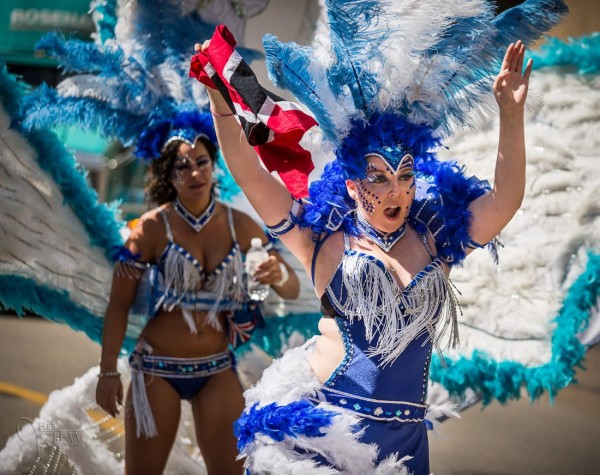
Notice where I am standing here? In between the dancers, they literally walked around me!
**NOTE: do not get yourself in trouble, if the parade marshal or police tell you to cease and desist please listen to them and follow their guidelines. Perhaps find out ahead of time if you need special permission to walk the parade route.**

I followed this float for 5 blocks because their music was so good!
Joining the parade either officially, or unofficially can get you closer to the action. Volunteer to be security, or help out and ask if you can bring your camera along. You may get access to backstage areas, or being on the street in places that you might not otherwise get to go. Many parades, at least here anyway, encourage people to get up and join in and march along behind the bands, or dance behind the floats with the great music. That’s part of what makes parades to universally fun. We have a parade called “Cariwest” which is a celebration of Caribbean culture and music. They highly encourage people to follow them and dance along the entire parade route. I love to attend this parade because it’s so colorful and I can get close to the action. Try to find ones like this, often in smaller cities or towns the rules are more relaxed, so get out of the big city if need be.
As I mentioned earlier you can encounter some really tricky lighting situations at a parade. I tend to like to put the sun behind my subjects, then I expose so they are well lit and the background gets overexposed or blow out. I’m fine with that as opposed to the opposite of drab photos in the shade with no sense of drama and separation. The sun creates a rim light (outline on the subject) and separates them from the usual boring buildings behind them.
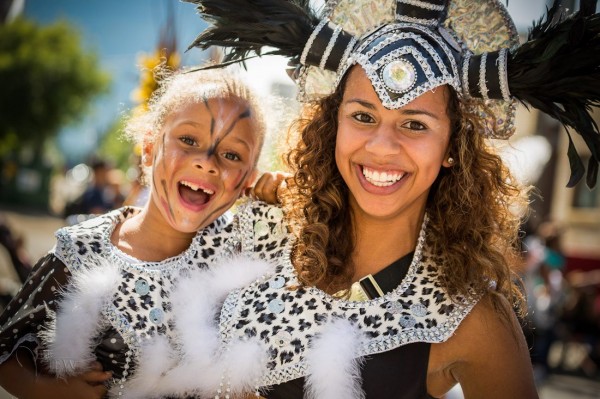
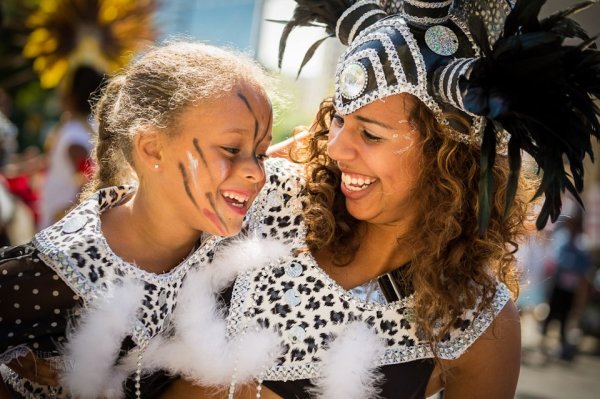
Often in my beginner photography classes my students assume that the longer telephoto and zoom lenses are for photographing things far away. While that is sometimes the case, as in wildlife or birds, they have other great uses as well. See my article on “How to achieve blurred backgrounds in portraits” as those tips apply here as well. Using a longer lens and large aperture, will help you get the distracting background of the parade route more out of focus.
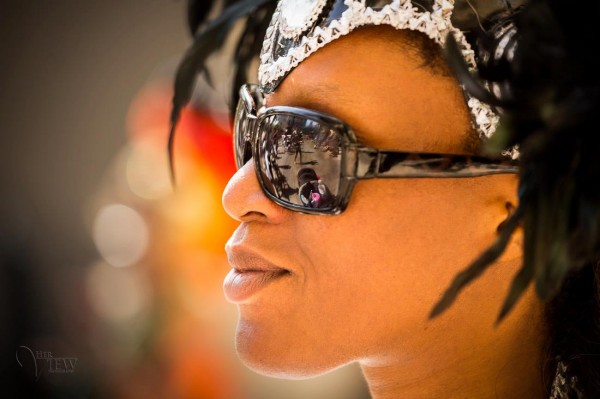
First it let’s them see you’re taking their photo, and allows interaction with them if only by eye contact. They know they’re on display in the parade and expect to have their photo taken many times. So if you are hesitant or tentative taking people’s photos this is a perfect opportunity because you have a whole stream of willing subjects literally parading in front of you (sorry pun intended). Sometimes you’ll get a great reaction when they see your camera like the series of images below. She turned, saw me, and I captured a few shots as she rotated and pointed right at me. If I were out on the street edge, likely that wouldn’t have happened.



Second, it will simplify your images and allow you to focus more on one thing at a time. Parades can be visually stimulating, and overly busy so getting in closer will help solve those problems. Pick one person, or one part of a float and get closer.
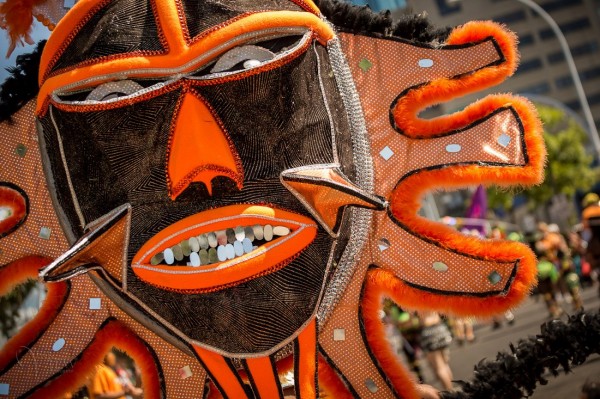
Float details
Over on my own site I wrote “What is your message? Storytelling photography” and gave some examples. As you photograph the parade try and create a series of images that tell the story of the event, and relate it to someone that wasn’t there. What do you see, hear, feel, taste and touch? What is the main thing you want tell people that see your images of the parade? Journalists will say that you need to cover: wide, medium and long. What that means is show the big picture by shooting some wide shots; show the medium range like one person or one float; and show long or tight shots like details of costumes of floats or musical instruments. Try to also capture some action images, dancers in mid-bounce, drummers with hands or drumsticks all a blur in motion. A story also needs a beginning, middle and end. Think of those things while you photograph and you may surprise yourself with the results.


Hmm, is it just me or are these firemen enjoying the parade just a little too much?!
Don’t forget to drink lots of water, stay hydrated, and have some FUN with it!
Have a great summer (if you’re in the northern hemisphere) and enjoy it while it lasts.
Post originally from: Digital Photography Tips.
Check out our more Photography Tips at Photography Tips for Beginners, Portrait Photography Tips and Wedding Photography Tips.
6 Tips for Getting Better Parade Photos
You must be logged in to post a comment.